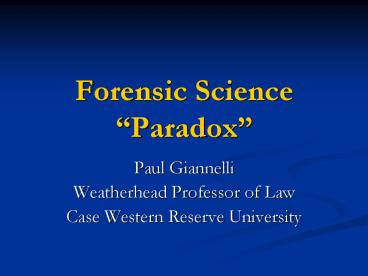Forensic Science Paradox - PowerPoint PPT Presentation
1 / 24
Title:
Forensic Science Paradox
Description:
... two people would have head hair or pubic hair so similar that they could not ... odds of both head and pubic hair from two people being indistinguishable would ... – PowerPoint PPT presentation
Number of Views:192
Avg rating:3.0/5.0
Title: Forensic Science Paradox
1
Forensic ScienceParadox
- Paul Giannelli
- Weatherhead Professor of Law
- Case Western Reserve University
2
Early Cases
- Fingerprints People v. Jennings (1911)
- Firearms (ballistics ) Identifications
- Sacco Vanzetti (1927)
- Burchett v. State (Ohio App. 1928)
- St. Valentines Day Massacre (1929)
- Handwriting Comparison
- Lindbergh Kidnapping Trial (1936)
3
Lindbergh Case
- Bruno Hauptmanns conviction in the Lindbergh
case created landmarks in scientific crime
detection, in the utilization of forensic
scientists, and in the courtroom presentation of
scientific and demonstrative evidence. - Baden, 28 J. Forensic Sci. 1035 (1983).
4
Lindbergh Case
- Albert Osborn, one of the handwriting experts in
the trial, became a kind of public hero, and the
validity of scientific handwriting
identification when practiced by a competent
practitioner became public knowledge . . . . - Risinger et al., 137 U. Pa. L. Rev. 731, 738
(1989)
5
Sacco Vanzetti
- Experts affidavit repeatedly told the
prosecutor that he would have to answer in the
negative if he were asked whether he had found
positive evidence that the fatal bullet had been
fired from Saccos pistol. - Trial Testimony My opinion is that it is
consistent with being fired by that pistol. - Joughin Morgan, The Legacy of Sacco Vanzetti
15 (1948).
6
Development of Crime Lab
- 1923 L.A. Crime Lab
- August Vollmer Berkeley Criminology Depart
- 1930 L.A. Sheriffs Lab
- 1931 California State Lab
- 1929 Northwestern Law School
- Calvin Goddard John Henry Wigmore
- 1938 Chicago Crime Lab
- 1933 F.B.I. Crime Lab
7
Crime Labs as Reform
- Frankfurter, The Case of Sacco and Vanzetti 30
(1927) (What is the worth of identification
testimony even when uncontradicted? The
identification of strangers is proverbially
untrustworthy.). - Brown v. Mississippi (U.S. 1936) (due process
violated by beating a confession out of a
suspect).
8
Pres. Johnsons Crime Comm.
- The great majority of police department
laboratories have only minimal equipment and lack
highly skilled personnel able to use the modern
equipment now being developed. - Presidents Commn on Law Enforcement and
Administration of Justice, The Challenge of Crime
in a Free Society 255 (1967)
9
Pres. Nixons Crime Comm.
- Too many police crime laboratories have been set
up on budgets that preclude the recruitment of
qualified professional personnel. - National Advisory Commn on Criminal Justice
Standards and Goals, Report on Police 304 (1974)
10
Proficiency Testing (1978)
- 200 crime laboratories
- blood test 71
- paint samples 51.4
- soil examination 35.5
- firearms identifications 28.2
- Wide variability in labs
11
ASCLD/LAB (1981)
- American Society of Crime Lab Directors/Laboratory
Accreditation Board - Quality assurance programs
- proficiency testing, technical reviews, audits,
and - corrective action procedures.
- Only 10 of labs pass on first inspection.
- Investigations Fred Zain
12
Developments 1988-1993
- DNA Litigation
- People v. Castro (1989)
- Daubert v. Merrell Dow Pharm. (1993)
- Supreme Courts junk science decision
- Lab Abuse Cases
- W. Virginia Crime Lab (Fred Zain) (1993)
13
DNA Admissibility Wars
- University science, not forensic science
- Science culture
- written protocols
- quality assurance/quality control
- proficiency testing
- Open science vs. adversarial science
14
DNA Gold Standard
- What DNA Fingerprinting Can Teach the Law About
the Rest of Forensic Science? - forensic scientists, like scientists in all
other fields, should subject their claims to
methodologically rigorous empirical tests. The
results of these tests should be published and
debated. - Saks Koelher, 13 Cardozo L. Rev. 361 (1991)
15
DNA Identification Act (1994)
- Combined DNA Index System (CODIS).
- DNA Advisory Board (DAB) created to assist in
promulgating quality assurance standards. - Proficiency testing for FBI analysts etc.
- New York established Commn on Forensic Science.
16
Garrett, Judging Innocence, 108 Colum. L. Rev.
55 (2008)
- 200 DNA exoneration cases
- Eyewitness identifications 79
- Forensic evidence 57
- Informants testimony 18
- False confessions 16
17
Forensic Evidence
- Pre-DNA serology 79 cases
- Hair comparison 43
- Soil comparison 5
- DNA analysis 3
- Bite marks 3
- Fingerprints 2
- Dog scent ident. 2
- Voiceprints, shoe prints, fibers 1 each
18
Williamson v. Reynolds
- Expert microscopically consistent
- Expert There could be another individual
somewhere in the world that would have the same
characteristics. - Williamson v. Reynolds, 904 F. Supp. 1529, 1558
(E.D. Okl. 1995) revd on this issue, Williamson
v. Ward, 110 F.3d 1508, 1522-23 (10th Cir. 1997)
(due process, not Daubert, standard applies in
habeas proceedings)
19
Edward Honaker
- Expert Crime scene hair sample was unlikely to
match anyone other than the defendant. - Another expert would later conclude the hairs
were not comparable. - Exonerated by DNA.
20
State v. Bromgard
- Expert The odds were one in one hundred that
two people would have head hair or pubic hair so
similar that they could not be distinguished by
microscopic comparison and the odds of both head
and pubic hair from two people being
indistinguishable would be about one in ten
thousand. - State v. Bromgard, 862 P.2d 1140, 1141 (Mont.
1993)
21
Current Issues
- Empirical support for forensic techniques
- Saks Koehler, The Individualization Fallacy in
Forensic Science Evidence, 61 Vand. L. Rev. 199
(2008). - Regulation of crime labs
- Giannelli, Wrongful Convictions and Forensic
Science The Need for Regulation, 86 N.C. L. Rev.
163 (2007).
22
(No Transcript)
23
(No Transcript)
24
(No Transcript)































